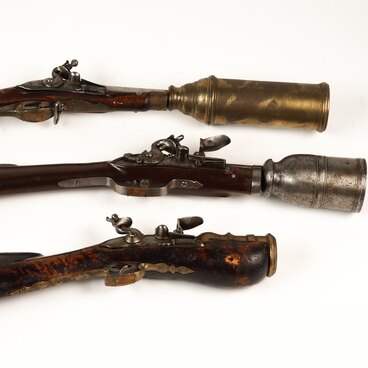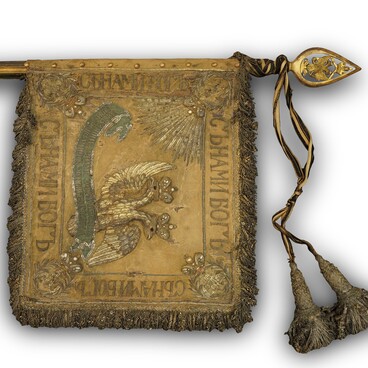Short-barreled mortars were used primarily as siege weapons. They fired projectiles at an angle of 20 degrees or even steeper that easily flew over ramparts and fortress walls.
In the 17th and 18th centuries mortars were divided into so-called “sitting” and “hanging” ones. A flat pallet together with the barrel was cast on the breech of the “sitting” mortars, and the gun was placed on the pallet as well. The “hanging” ones were installed in special mortar support mounts so that the barrel rested on them by the trunnions (the side projections). These mounts were placed directly on the ground.
In the 16th century, mortars were loaded with pellets as those were the most accessible. Since the 17th century, explosive shells replaced them — they were cast-iron cannonballs filled with gunpowder. The shells were divided by weight into “grenades” (less than one pood, that is, 16.2 kg; hence the term “grenadiers”) and bombs (from one pood or more).
A round through-hole was made in the body of the projectile which is also called a point. A grenade tube — a wooden truncated cone drilled through the central axis — was inserted into it. To prevent the projectile from prematurely exploding, the tube was filled with well-packed compressed gunpowder. The powder gases ignited the gunpowder during the shot, and when it completely burned out, the bomb or grenade exploded.
Until the middle of the 18th century, it was customary to “fire twice” from mortars. To do it, a shell was placed in the mortar’s barrel, first its grenade tube was lit with a linstock, and only then — the priming powder.
Later, two pieces of a pre-prepped slow match were put into the tubes. The match was made of untwisted cotton thread and smeared with compressed gunpowder soaked in vinegar or wine. Before firing, the ends of the slow match were straightened along the shell body. The powder gases burned the threads, igniting the grenade tube from them.
Maintenance of mortars and firing from them were very dangerous, so only experienced gunners were allowed to do it.
The mortar presented in the exhibition was cast in Amsterdam by the foundry master Claudius Fremy. According to European tradition, the gun is decorated with an aphorism “From the strong the strong are born” and features the “passport data” of the gun itself, “Fremy made me in Amsterdam in 1695.”
This was not the first product made by Fremy commissioned by the Russian government. In 1628, the master cast at least one of the bells for the clock of the Spasskaya Tower in Moscow Kremlin.
In the 17th and 18th centuries mortars were divided into so-called “sitting” and “hanging” ones. A flat pallet together with the barrel was cast on the breech of the “sitting” mortars, and the gun was placed on the pallet as well. The “hanging” ones were installed in special mortar support mounts so that the barrel rested on them by the trunnions (the side projections). These mounts were placed directly on the ground.
In the 16th century, mortars were loaded with pellets as those were the most accessible. Since the 17th century, explosive shells replaced them — they were cast-iron cannonballs filled with gunpowder. The shells were divided by weight into “grenades” (less than one pood, that is, 16.2 kg; hence the term “grenadiers”) and bombs (from one pood or more).
A round through-hole was made in the body of the projectile which is also called a point. A grenade tube — a wooden truncated cone drilled through the central axis — was inserted into it. To prevent the projectile from prematurely exploding, the tube was filled with well-packed compressed gunpowder. The powder gases ignited the gunpowder during the shot, and when it completely burned out, the bomb or grenade exploded.
Until the middle of the 18th century, it was customary to “fire twice” from mortars. To do it, a shell was placed in the mortar’s barrel, first its grenade tube was lit with a linstock, and only then — the priming powder.
Later, two pieces of a pre-prepped slow match were put into the tubes. The match was made of untwisted cotton thread and smeared with compressed gunpowder soaked in vinegar or wine. Before firing, the ends of the slow match were straightened along the shell body. The powder gases burned the threads, igniting the grenade tube from them.
Maintenance of mortars and firing from them were very dangerous, so only experienced gunners were allowed to do it.
The mortar presented in the exhibition was cast in Amsterdam by the foundry master Claudius Fremy. According to European tradition, the gun is decorated with an aphorism “From the strong the strong are born” and features the “passport data” of the gun itself, “Fremy made me in Amsterdam in 1695.”
This was not the first product made by Fremy commissioned by the Russian government. In 1628, the master cast at least one of the bells for the clock of the Spasskaya Tower in Moscow Kremlin.




